
23 Jul Geomorphic cycles
Geomorphic Cycles – UPSC Geography Optional Notes
In physical geography, the concept of geomorphic cycles refers to the theoretical framework used to explain the evolution of landscapes through a series of stages caused by the interaction of internal and external earth processes. This is an important topic under Paper 1 of UPSC CSE Geography Optional syllabus.
1. Introduction to Geomorphic Cycles
The concept of geomorphic cycles helps in understanding the progressive development and decline of landscapes over geological time scales. The main idea is that all landforms go through stages of formation, development, and decay under the influence of exogenic forces, primarily erosion and weathering.
2. William Morris Davis and the Cycle of Erosion
American geographer William Morris Davis introduced the concept of a ‘Geographical Cycle’ or ‘Cycle of Erosion’ in the late 19th century. According to Davis, landforms evolve in a sequence of stages under the influence of erosion acting on uplifted land.
Stages of Davisian Cycle:
- Youth: Rapid vertical erosion, steep V-shaped valleys, waterfalls.
- Maturity: Lateral erosion begins, meanders form, valleys widen.
- Old Age: Erosion dominates, peneplain formation, subdued relief.
Key Assumptions: Rapid uplift followed by a long period of stability; dominance of fluvial erosion; uniform rock structure.

Geomorphic Cycles and land scape
3. Walther Penck’s Model
German geomorphologist Walther Penck proposed an alternative to Davis’ model. His theory emphasized the role of simultaneous uplift and denudation.
Features of Penck’s Model:
- Landforms evolve through continuous processes rather than discrete stages.
- Valley slope forms are critical indicators of evolutionary status.
- Backwearing of slopes vs. downwasting.
4. King’s Cycle of Pediplanation
L.C. King developed the concept of pediplanation while studying arid and semi-arid landscapes. It challenged Davis’s peneplanation in dry regions.
Key Concepts:
- Formation of pediments at the foot of hills due to parallel retreat of slopes.
- Pediplains form through the coalescence of pediments.
- More applicable to tropical and arid zones.
5. Comparison of Davis, Penck, and King
| Aspect | Davis | Penck | King |
|---|---|---|---|
| Uplift | Sudden | Gradual | Gradual |
| Process | Sequential stages | Continuous slope change | Parallel retreat |
| Region | Humid | Mixed | Arid/Tropical |

6. Agents of Geomorphic Change
- Rivers – Fluvial cycle (Davis)
- Glaciers – Glacial cycle of erosion
- Waves – Marine cycle
- Wind – Aeolian processes in deserts
- Groundwater – Karst landscapes
7. Criticism of Geomorphic Cycle Theories
- Assumes ideal conditions and overlooks variability of climate, geology, and tectonics.
- Ignores human-induced changes and rapid tectonic events.
- Too deterministic and descriptive, less quantitative.
8. Contemporary Relevance
- Provides a foundation for understanding landscape evolution.
- Helps in predicting geomorphic hazards.
- Useful for environmental planning and infrastructure development.
- Assists in terrain classification and resource management.
9. Indian Examples
- The Chhota Nagpur plateau shows stages similar to Davis’ cycle.
- Western Ghats display features explained by parallel retreat (King’s Model).
- Aravallis as relict landforms undergoing geomorphic rejuvenation.
10. Past Year UPSC Questions
- 2021: Discuss the relevance of Davisian cycle of erosion in present-day geomorphology.
- 2015: Compare and contrast the geomorphic ideas of Davis and Penck.
- 2013: Explain the concept of pediplanation and its applicability in Indian context.
11. Probable Questions for UPSC
- How far are geomorphic cycle theories relevant in an era of rapid climatic and tectonic changes?
- Critically evaluate the contribution of L.C. King in arid geomorphology.
- Explain how tectonic activity interacts with erosion cycles to shape landforms.
12. Conclusion
Geomorphic cycles, though criticized for being idealistic, have played a vital role in the theoretical development of geomorphology. Understanding these cycles is crucial for comprehending the long-term evolution of Earth’s landscapes. The models by Davis, Penck, and King provide distinct perspectives and continue to influence contemporary studies and civil planning.
Best geography optional coaching
Best geography optional teacher
Best geography optional test series




No Comments